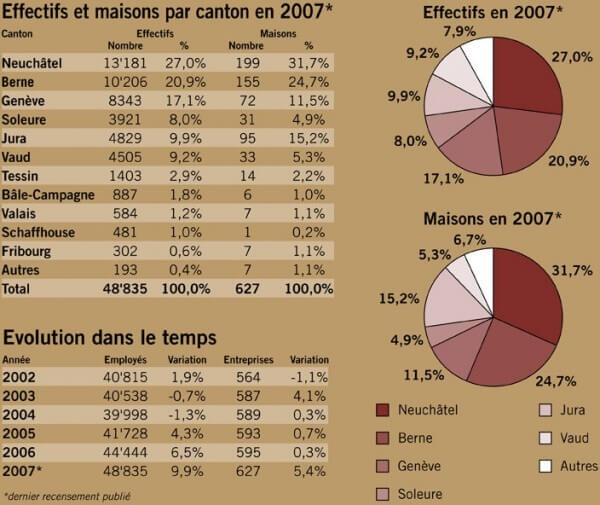The early months of 2009 continue to send economic indicators into a spin. “Incoming orders are down and production is stagnating. Earnings and profits have shrunk despite an increase in prices,” observed Carla Duss, an economist at UBS commenting on the bank’s latest barometer. No other sector of industry in Switzerland is gearing up for such a tough first quarter 2009. According to Carla Duss, “watch companies are anticipating a drop in new orders, a major cut-back in production, all branches taken together, and that earnings and profits will slide.” Obviously this will mean hauling in the sails, i.e. cutting back production capacity or, to put it another way, bring about redundancies, job losses and short-time working. Making a list would be pointless as it would be out of date in a week’s time.
How many will survive?
For some observers, though, there’s no call to panic after five years of almost full employment, based on current economic criteria. It’s worth remembering that the watch industry has never created as many new jobs as during these halcyon years. Almost 9,000 workers joined the branch, an increase of 22% over three years. Whatever the outcome, the industry isn’t about to relive the disastrous scenario of thirty years ago. “Watchmaking isn’t caught up in a structural crisis; it is going through a more delicate phase due to the current climate,” opined Nick Hayek, CEO of the Swatch Group. In the 1970s and 1980s, new technologies, such as the advent of quartz watches, and economic challenges led to a radical resizing of the branch. From some 90,000 employees in 1970, numbers fell to just over 30,000 in 1984: 60,000 jobs went by the wayside in less than fifteen years. These losses were at least partially offset: the last census, in 2007, showed that some 50,000 people were employed in the branch.
How many will be left once the storm has passed? “No one can say. The next available figures will be for the 2008 census, which takes us up to September when the credit crunch had yet to strike. We can expect figures to go through the roof,” explained François Matile, secretary-general of the CPIH, which regroups employers in the Swiss watch industry. UBS predicts that watchmaking will be among those branches to be hardest-hit. With unemployment in Switzerland set to rise from 2.6% in 2008 to 3.3% in 2009, and possibly 4.3% in 2010, according to the latest forecast from the State secretariat for economic affairs, there could be some major fallout. Doomsayers are predicting that once the crisis is over, the watch industry will employ the same number of people as in 2004, i.e. fewer than 40,000. Many would say this is painting too bleak a picture. François Matile, for one, isn’t expecting such a haemorrhage: “We can expect staff numbers to go up or down by between 1.5% and 3%, depending on what kind of turn the economy takes.” Jobs most at risk are in production, which will have to adjust to shrinking order books, in which case companies are most likely to say goodbye to their less skilled workers. “There will still be demand for highly-qualified watchmakers who are specialised in the most complex complications,” Luigi Macaluso, CEO of Girard-Perregaux, commented. They can breathe easy, then. Note that over a fifteen-year period, the proportion of unqualified workers has fallen from almost 66% to around 40% today.

Still jobs for the young
Contractors will need to adjust staff numbers too, although François Matile isn’t convinced by the “one for three” ratio currently being bandied about: for every job lost at a watch brand, three jobs will be cut upstream, at suppliers. “This isn’t the case for large integrated groups. Having one less watchmaker in production doesn’t mean three people lose their jobs in dials and cases.” All the experts agree that the crisis will bring some benefits. Nicolas Hayek recommends taking advantage of this period to develop ongoing training for staff.
For the time being, world recession hasn’t dinted watchmaking’s appeal for young people. While there has been a very small drop in intake at vocational schools, watchmaking is still an attractive career choice. At the École d’Horlogerie du Locle, in the Neuchâtel mountains, the number of new students has fallen only slightly, from 140 to 110. As François Matile points out, “from four candidates for every available job in 2007-2008 there are 3.5 today.” Rest assured then that the next generation is waiting in the wings, which is especially good news for those companies that are still recruiting. “We’ll be hiring between 25 and 30 people this year for our new manufacturing facilities in Nyon,” revealed Jean-Claude Biver, CEO of Hublot which is part of the LVMH group. One thing is for sure: the handful of companies that do recruit new staff will be setting the bar high, after the “anything goes” of recent years. Such an emphasis on quality can only pay off in the future. Once the storm has passed…










